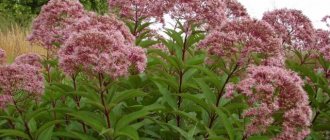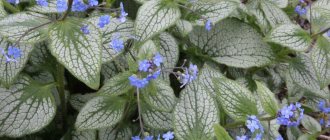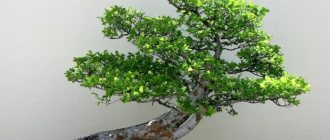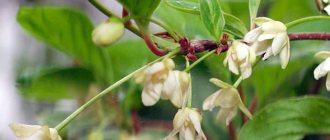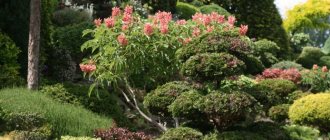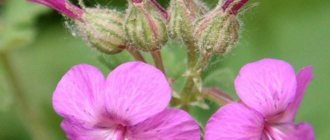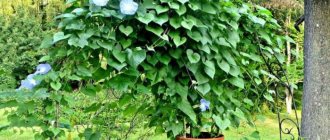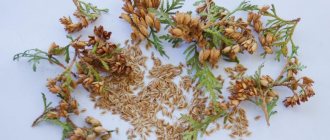Winged euonymus is a garden ornamental shrub. The peculiarity of the plant and its beauty lies in the oval elongated leaves, which during the season change color from bottle green to purple-red.
Interestingly, one sheet can have up to five shades of a color palette; the colors smoothly flow into each other, creating the illusion of watercolor painting.
The winged euonymus in the garden is a decoration of the site in the fall, when the bright drooping foliage resembles a flock of butterflies clinging to the branches at the bottom of the trees. It is not capricious in care, so it easily takes root in any latitude.
The winter hardiness of winged euonymus is amazing; the shrub requires virtually no preparation for cold weather.
Description of the species
The winged euonymus (Euonymus alatus) was brought to Russia from Southeast Asia. It belongs to the deciduous shrubs of the genus Euonymus of the Euonymus family. The shrub up to 1.8 m high has a creeping form. In the wild it can reach up to 4 m in height. The annual growth is 15 cm. The crown is widely spread and branched. The shoots are green with leaves 2.5–7 cm long and 1–3 cm wide. The foliage has an ovoid, elliptical shape. In autumn it turns pink or purple.
Did you know? People also call euonymus “wolf earrings”, “preskurina”, “bruslina”.
The growing season of winged euonymus is May – June. Each inflorescence produces 1–3 flowers. Petals up to 4 mm long are ovoid, greenish-white. The fruit is presented in capsules, which have a special aesthetic value in the fall, when they acquire a rich red hue.
Photo.
Euonymus winged Compactus in summer, lat. Euonymus alatus 'Compactus'.
Euonymus winged Compactus in summer, lat. Euonymus alatus 'Compactus'.
Euonymus winged Compactus in autumn, lat. Euonymus alatus 'Compactus'.
Euonymus winged Compactus in autumn, lat. Euonymus alatus 'Compactus'.
Euonymus winged Compactus in autumn, lat. Euonymus alatus 'Compactus'.
Varieties
There are several varieties of winged euonymus: Chicago Fire, Compactus, Fireball, Macrophilis. Each variety differs in the size of the bush, crown shape, foliage and fruit color. Next we will talk in detail about each variety.
We recommend reading about the euonymus variety Harlequin.
Compactus
Euonymus variety Compactus (Compactum) has a height of up to 1.5 m and a diameter of 2 m. The shape of the crown is regular and openwork, with neat edges. In summer the leaf color is green, but by autumn it changes to red-violet. The leaves are oval, up to 5 cm long. The flowers are small, yellow-green, appear in May. The fruits ripen in the fall, when their color turns bright orange or red. They remain on the bush until frost. The Compact variety prefers sunny areas; it does not develop well in the shade.
Chicago Fire
Chicago Fire reaches a length of 1.2 m and a width of 1.5 m. Horizontal branches form a rounded crown. The leaves are dark green and elliptical in shape. By autumn, the color of the leaves changes to crimson.
Important! Euonymus Chicago Fire is resistant to cold weather. Its shoots freeze only in particularly severe frosts, but are easily restored in the spring.
The shrub produces small flowers from which dark red fruits appear. Fertile soil is best suited for growing this variety.
Fireball
Fireball is represented by plants up to 1.5 m high, which have a spherical crown shape. The diameter can also reach 1.5 m. The average growth per year is 5–10 cm in girth. The green foliage is elliptical in shape. In autumn it turns purple-red. The flowers, which appear in May, do not stand out among the green branches due to their muted lime-yellow hue. Red fruits are stored in boxes.
Macrophilis
The Macrophilis variety is represented by shrubs whose height reaches 1.5 m and width - 1.2 m. The main difference from other varieties is the elongated shape of the leaves. In autumn they turn bright orange or purple-red. It grows well in sunlit areas with fertile soil and moderate amounts of moisture.
Reviews of winged euonymus
Kovalskaya Lyudmila Petrovna, 48 years old, Moscow region
I have been looking for a beautiful ornamental shrub for my garden for a long time. Based on reviews, I chose winged euonymus Chicago Fire and did not regret it at all. The bush has become a real decoration for the garden. The variety is unpretentious to the soil, does not get sick, and tolerates pruning well. The main disadvantage is that it is a slow variety. Therefore, I do not recommend growing it from seeds; it is better to purchase a seedling. My bush grows in a sunny area, so in the fall it pleases with bright colors.
Orlova Valeria Stepanovna, 26 years old, Nizhny Novgorod
At my relatives' dacha I saw a beautiful bush with bright crimson leaves. It turned out that this was an euonymus of the Macrophilis variety. I took a couple of cuttings home, which I planted near the house after rooting. In the first year, the tree grew by 30 cm. Now its height is almost human height. The plant is completely unpretentious, and at the same time has a wonderful decorative appearance. I care for the shrub at a minimum: in the fall and summer I feed it with mineral fertilizers.
Application in landscape design
The plant surprises with its variety of forms and can be used both in single and group plantings. If the shrub is planted as a tapeworm, then it needs to be given enough free space.
Did you know? The essential oil and resins contained in euonymus are used in medicine and in the beauty industry.
Low-growing perennial plants, including flowers, can be planted around. Euonymus goes well with barberry bushes and other ornamental plantings, such as jasmine and rose hips. The plant is great for decorating summer cottages, gardens, recreation areas, parks and alleys. The bush looks appropriate near terraces, ponds and fountains.
Peculiarities
Thanks to their spectacular coloring, euonymus is gaining popularity both in landscape gardening in cities and in decorating private properties. Bright bushes are used alone or in groups; they are used to create hedges and garden sculptures. The crimson, ruby, and burgundy foliage of winged euonymus favorably sets off autumn gardens and decorates faded flower beds.
Any conifers, herbs, or bushes with contrasting colors are good companions for shrubs. A bright autumn landscape can be created by combining euonymus with viburnum, rose hips, barberry or broom bushes.
In addition to the undeniable decorative effect, gardeners note other advantages of the bright shrub:
- frost resistance;
- responsive to any type of fertilizer;
- undemanding to haircut, easy to shape;
- decorative fruits that imitate winter flowering;
- ease of reproduction and good survival rate.
Among the disadvantages of growing winged euonymus is the loss of decorativeness in the shade. Some gardeners believe that the growth of the bush is too slow, and that a large plant has to wait too long.
The winged euonymus with its bright autumn attire completely covers the expectations and concerns of gardeners. Photos and descriptions of crimson bushes or ruby trees show the possibility of growing this exceptionally decorative and at the same time hardy crop not only in a garden or park, but even on a polluted city street.
Landing
In order to grow a beautiful and healthy shrub, it is important to follow all planting rules. Euonymus and its root system tend to actively grow every year, so you need to ensure a distance of 3-4 m from other plants and buildings.
You will be interested to read about the features of growing indoor euonymus.
Site selection and soil preparation
For winged euonymus, choose a sunny place or partial shade, but the color of its foliage and fruits depends on the lighting. On a bush that is located in a lighter and more spacious area, the fruits and leaves acquire bright colors by autumn. The soil should be light and nutritious. The root system of the plant is thin and spreading, so it is sensitive to the mechanical composition of the earth. It is advisable that before planting it be cleared of weed roots, stones and other impurities.
If the soil in the area is acidic, it will be limed prematurely.
Landing dates and rules
Planting can be done from spring to mid-autumn.
It will be useful for you to know what euonymus is.
To plant euonymus, you must perform the following steps:
- Dig a hole that will be 2 times larger than the root system of the seedling.
- Prepare a soil mixture of peat, soil and sand in a ratio of 2:1:1.
- Fill the bottom of the hole with earthen mixture and compact it.
- Place the root ball in the hole and cover it with prepared soil so that its edges do not remain exposed.
- Water the tree trunk circle and mulch it with peat or fallen leaves.
Diseases and pests
Euonymus is susceptible to powdery mildew. The disease manifests itself as a white coating on the leaves. To combat the lesion, Bordeaux mixture or copper oxychloride is used. The bush is sprayed in dry, cloudy weather. If necessary, the treatment is repeated after a week.
The shrub may suffer from attacks by aphids, caterpillars and spider mites. Insects feed on plant juices. As a result, the development of the euonymus slows down, the leaves curl and fall prematurely. The preparations Fitoverm and Confidor are effective against pests. Spraying is carried out every 10 days.
To prevent diseases and pests, it is important to follow agricultural practices. In autumn, dig up the soil and remove fallen leaves.
Proper care
Plant care includes watering, fertilizing and pruning. It is important that the soil at the root of the bush remains constantly moist, but without excessive stagnation of water. In dry weather, watering is done more often than usual. The shape of the plant can be created by cutting.
Video: planting and caring for winged euonymus
Watering
The root system of the shrub prefers soil with moderate moisture. Drying of the soil and stagnation of water will disrupt the proper growth and functioning of the plant. To prevent moisture from evaporating so actively during periods of summer drought, the tree trunk circle needs to be mulched with humus or peat. After rain or artificial watering, the mulch layer must be renewed.
Top dressing, fertilizer
Feeding is carried out throughout the season. In the spring, before the first buds appear on the shoots, nitrogen organic fertilizers are applied, for example, mullein or an infusion of chicken manure. Complex fertilizers are more suitable for the summer period. These include preparations for feeding ornamental plants based on phosphorus, potassium or nitrogen, which can be purchased in specialized stores.
Also check out the uses of Fortune's euonymus varieties.
In autumn it is best to use mineral complexes. Per 1 m² you need to add 400 g of potassium sulfate and 500 g of superphosphate. Fertilizers in dry form are buried to a depth of 10 cm, and the solutions are watered around the tree trunk.
Trimming
Pruning is used to correct the shape of the crown of the bush. Most landscape designers try to give the plant the shape of a regular ball or a flattened ellipse. The procedure is carried out with clean garden tools in early spring before the sap begins to flow or in the fall, after the leaves have fallen. Sanitary pruning is performed annually to remove diseased and pest-infested branches. Dry and broken shoots also need to be cut out.
Important! By pinching young shoots, you can create an ellipsoidal or cone-shaped crown of the euonymus.
Preparing for winter
Having properly prepared the euonymus for wintering, you don’t have to worry about its condition next year. First of all, you need to provide abundant autumn watering. To do this, pour about 40 liters of water under the bush, after which the ground around the trunk is mulched. Watering is needed to slow down soil freezing and prevent damage to the root system.
Young specimens require shelter, which is created from metal arcs and non-woven material that allows air to pass through, for example, agrofibre. The structure must be removed in the spring, after the snow has thawed.
Planting correctly
In general, winged euonymus is not a very demanding plant. It is planted in spring and autumn, like most other shrubs. But, since this is still a heat-loving plant, it is better to plant it in the spring.
The winged euonymus loves light, but grows normally in shaded places. The soil needs to be neutral or slightly alkaline (lime should be added to acidified soil). Another important soil requirement is sufficient aeration. The soil should have good air permeability and be loose. A suitable soil mixture for planting consists of garden soil, compost, sand and a small amount of wood ash or lime. It is also necessary to add complex fertilizer.
For planting, we prepare a hole, which should be twice the volume of the roots with an earthen lump. Although winged euonymus is unpretentious, stagnation of water will cause disease and death of the plant. Therefore, at the bottom of the hole we make sure to arrange good drainage (at least 15 cm), for this we use expanded clay, gravel, broken brick, coarse sand, etc. After planting, we compact the soil, water it well and mulch.
Since winged euonymus is poisonous, care should be taken when working with it. The same applies to its brothers: warty euonymus, Japanese euonymus, European euonymus and others.
Reproduction
Euonymus can be propagated by seeds, layering and cuttings. Cuttings are considered the best way, since green specimens take root well in water. Seed propagation requires more time and effort, because seeds need stratification before planting.
We recommend reading about propagating euonymus by cuttings at home.
Cuttings
To propagate a plant by cuttings, in the summer it is necessary to select high-quality planting material. For these purposes, even shoots 10–12 cm long are suitable. They must be immersed in water with a growth stimulant (Kornevin, Fito Stimul). It is necessary for better root formation. Next, the cuttings need to be planted in a container with fertile soil and placed in a greenhouse. Next spring, the finished planting material can be planted in open ground.
Seeds
It is better to sow seeds in the soil in the fall. The planting site must be mulched with dry leaves, peat or straw. Before spring planting, seeds need to be stratified for six months. To do this, they need to be stored in damp sand in the refrigerator. Prepared planting material must be sown in holes 2 cm deep. Shoots appear after two weeks. The shrub is transplanted to a permanent place only in the third year.
